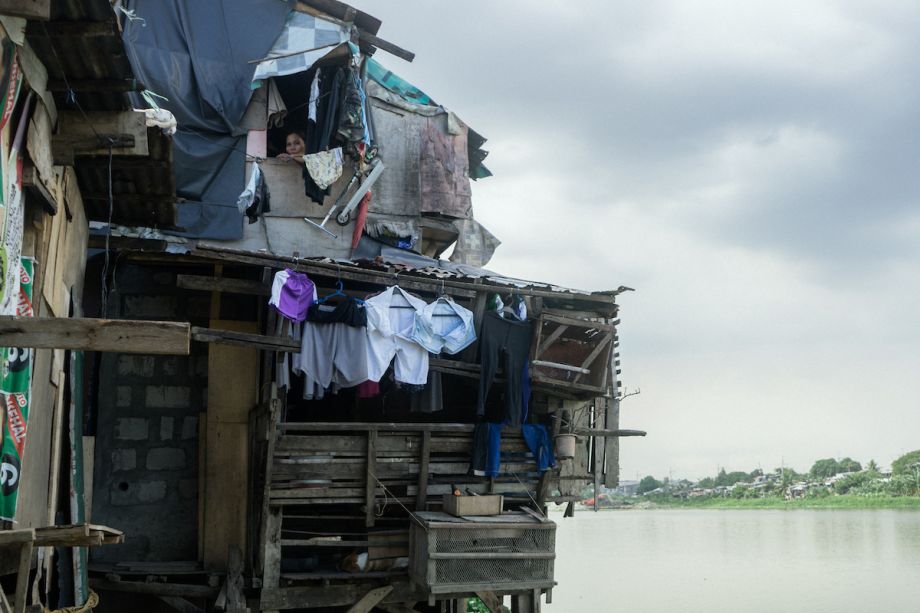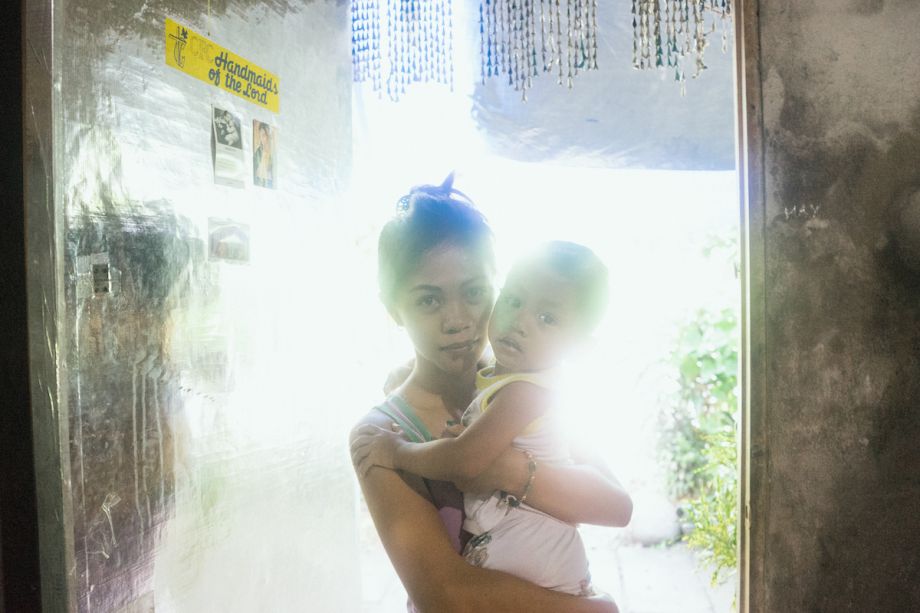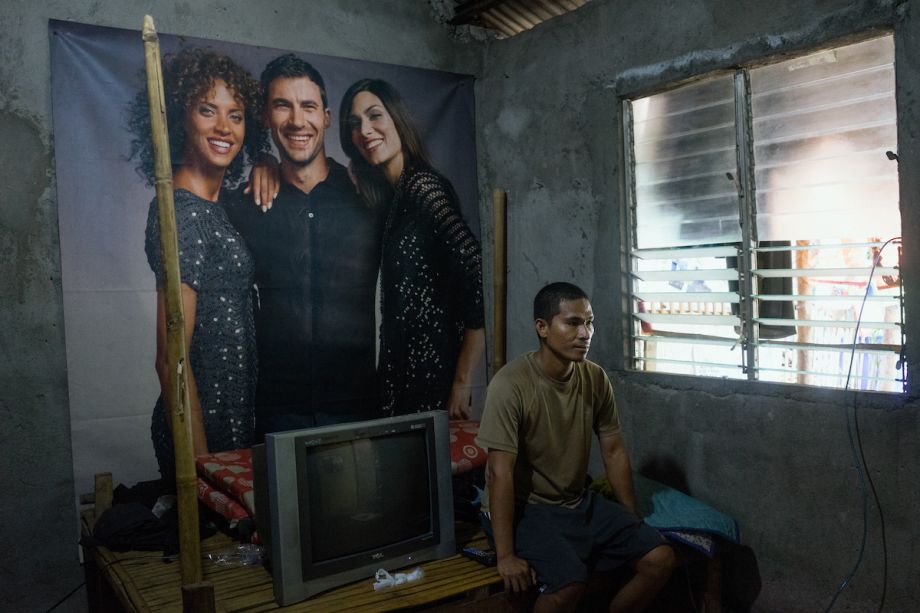Are You A Vanguard? Applications Now Open
This is your first of three free stories this month. Become a free or sustaining member to read unlimited articles, webinars and ebooks.
Become A MemberBayan ni Juan sits at the foot of the verdant green cone of Mount Kalisungan in Calauan, Laguna, a town 80 km south of Manila, the sprawling capital of the Philippines.
A gated community made up of low, cement-block rowhouses and wide streets lined with banana trees, tropical palms and dripping, broad-leafed vines, Bayan ni Juan bears little resemblance to the refugee camps seen on television or in the news. But while there are no UN peacekeepers or temporary latrines, the town has become an unlikely place of refuge for thousands of displaced Filipinos.
Over the past seven years since Typhoon Ondoy (internationally called Ketsana) dropped a month’s worth of rain in just 24 hours, 5,659 families have been moved from Manila and other typhoon-struck places to this scenic town.
Boy Achacoso, 49, belongs to one of those families and is one of 20 million people worldwide classified as a climate refugee. Alternatively called environmental migrants to avoid the narrow definition — and significantly higher financial and social responsibility — attached to the word “refugee,” the term describes people like Achacoso pushed to uproot because of climate-related environmental conditions.
Seven years ago, Achacoso lived with his family in a two-story, cement-block house he built himself on the banks of the Manggahan Floodway, one of Manila’s most dangerously flood-prone waterways. When Ondoy hit, Achacoso, his wife and four children first piled up furniture, trying to keep their heads above the raging floodwater. When that became futile, Achacoso punched a hole in the roof and crawled out to keep from being swallowed by the flood. From his rooftop, he saw the battered, found-wood remains of his neighbors’ homes get carried off by the current. An estimated 700 people drowned that day. The wreckage hadn’t yet been cleared when the government of the Philippines made Achacoso and his family into climate refugees — moving them, along with thousands of others, away from the water.
Despite its practically instant population boom, Bayan ni Juan retains a sense of isolation. A woman practices her shot alone at a homemade basketball hoop. A couple of children scoot around on shabby plastic trikes down the carless streets. But the seesaws and slides of a well-intentioned playground sit unused, the grass growing long beneath them. Many of the homes there are padlocked and abandoned. There are very few jobs.
“There are so many broken families here,” Achacoso says, as we wander the sleepy, commerce-free streets. As pleasant as the breeze may be, this is exactly the kind of place people migrate away from.

A woman peers from her home on the Manggahan floodway.
To survive in Bayan ni Juan, one member of the family may get a job in Manila, living in crowded bunks provided by the companies they work for, and coming home to their families every couple of months between contracts, or on the weekend if they can take it. Other families simply moved back to the Manggahan Floodway — opting to live with the prospect of another disaster instead of the daily strain of not having work.
Achacoso gives me the numbers of some of his neighbors who have returned to the Manggahan Floodway in Manila.
When I ask him how life is in his new home, he responds wistfully. “Ay wala, ma’am,” he says in Tagalog. There isn’t one.
For many of the world’s nations, climate change is a political abstraction. The Philippines is not one them. Eight of the top 10 cities most vulnerable to the impacts of a warmer, wetter planet sit inside the Pacific Ocean archipelago; its seawaters are rising up to five times faster than the global average.
Former U.S. Vice President Al Gore and the Climate Reality Project estimate that over time, 13.5 million Filipinos living along the island nation’s coastlines will have to migrate due to these rising seas and increasingly severe storms. In 2013, the Philippines bore the brunt of Super Typhoon Haiyan, the most powerful storm to make landfall in recorded history.
While Haiyan’s occurrence may not have been caused by climate change, its unprecedented strength was. At least 7,000 people died, and another 4 million people were displaced by that storm, with thousands of people crowding into military planes, ferries and buses to flee the disaster epicenter of Tacloban in the central Philippines for Manila.
Every hour, 29 people move to Manila. The historic capital is now the fastest-growing city in Southeast Asia, according to the United Nations and the London School of Economics. Where these migrants end up, however, is often no safer than the place they came from.
“The problem is huge,” says Avelino Tolentino III, director of policy development legislation for the Housing and Urban Development Coordinating Council. “It’s an accumulation of decades upon decades of doing this wrong, doing that wrong.”

A Filipina woman holds her baby in Bayan ni Juan.
Over the past year, Tolentino has dedicated untold hours to documenting exactly what has gone wrong in his country’s urban development in a 127-page national report. It will be presented in October in Quito, Ecuador, at Habitat III, the third convening of a United Nations conference on housing and urbanization that happens once every 20 years. Beyond Quito, the report is intended to inform the development of the nation’s own long-term development master plan. The Philippine Development Plan defines priorities from 2017 to 2022 in conjunction with newly elected President Rodrigo Duterte’s six-year term. Among other development goals like agricultural reforms and poverty alleviation, the plan places particular urgency on infrastructure development — in line with the Philippine Senate’s popular proposal to grant Duterte emergency powers to address traffic and other major infrastructure issues.
Despite the desire to take rapid action on the country’s overstressed system, building the infrastructure to undergird the existing challenges of Manila will not happen overnight. “It will take a long time. There are really no shortcuts. We’ve already been left behind,” Tolentino says. “We’re already at the point of ‘your cities are not ready for the level of urbanization.’”
He wears crisp-collared shirts and speaks in a tone of beleaguered optimism.
“In the first two years of government service I almost wanted to get out,” Tolentino says, “because there’s just so much. The problems are exponentially more than the resources that we have. But if you’re doing something like this, you have to be hopeful.”
The Philippines Habitat III report is a cold-eyed admission of what has gone wrong in the last 20 years since the last Habitat conference, and the opening pages of the document are grim, laying bare the failures in planning that have resulted in poor urban services, from troubled utilities and crumbling infrastructure to woefully inadequate public transportation and crushing traffic.
The document lays out the climate challenges already being felt — increased heat, rainfall, drought and storm surges, rising sea levels, water supply challenges, forest fires, and increased risks from typhoons, floods, and earthquakes — and offers urban planning strategies to mitigate their impacts. Things like viable transportation such as regional trains and bus rapid transit systems so Manila can comfortably accommodate a growing population without people resorting to riverside slums, and shifting from urban plans that favored cars to one that promotes walking, biking and public transportation. It recommends further supporting the national risk reduction systems that Philippine barangays — the country’s smallest unit of government, often no larger than a neighborhood or village — have been developing in earnest since 2010. It also recommends targeted subsidies for informal settlers, so people like Achacoso can enter the formal rental or mortgage market, and financing enough buildings to fill the acute need in fast-growing Manila, so more people currently packed into slums can move from makeshift shacks to climate and disaster-proof housing.
The short-term solution is to keep people in the city at higher densities by building high-rise public housing at locations where the residents can continue to access the city.
“The good thing is that it is getting a lot of traction in Congress and Senate,” says Tolentino of the efforts to find new, workable solutions to the chronic housing issues of informal settlers, particularly those who live, and keep returning to, riverside slums. “Now I think it is really a matter of financing it. It’s one thing to get support, it’s another to finance it.”
But even without these things, Tolentino says the creation of a 127-page report represents a step forward.
“There are baby steps that are hard to appreciate, especially at the present, when you are faced with all these realities that are quite discouraging … but it was grimmer in the past when we didn’t know about [these things],” he says.
His hope is that the Philippine government will catch up to the needs of the people, before another major disaster strikes.
“That’s the whole point of the New Urban Agenda,” says Tolentino, referring to the development guidelines and goals set to be adopted by UN nations in Quito at Habitat III. “If you want the new directions, you want to be able to identify the problems and say, ok, how do we make things better. And the only way you are able to cull those recommendations, is for you to face the issues.”
The New Urban Agenda won’t be binding and doesn’t offer detailed blueprints for how government can translate recommendations into action, but there are signs that the process of drafting it has already influenced the thinking of decision-makers in Manila.
Newly elected Vice President Leni Robredo, who will be heading up the Philippine delegation in Quito, won in part because of her reputation for supporting the needs of the urban poor. In addition to being the vice president, she serves as the head of the Housing and Urban Development Coordinating Council, and in that capacity, recently announced that Manila may suspend resettlement projects outside the city to places like Bayan ni Juan, which maroons people like Boy Achacoso and other climate refugees far from the city, until a workable solution is found.
Off-city relocation, which may seem like an initially quick fix to get riverside slum dwellers to safety, is proving to be a financial sinkhole too. “It’s a losing argument,” says Tolentino. “I don’t think you can stand there and argue for the viability of relocation sites when you see how hard it is to do it. We should really have a second look, take a long, hard look at in-city development.”
Whatever can be said about the slums of Manila, they are busy places.
A woman weighs oranges and apples for an off-duty security guard. Sidecar motorcycles rumble through the narrow streets, people belly up to corner eateries serving stews from giant aluminum pots. Front-yard mechanics and living room grocery stores fill the street side. Instead of the mountain, the tall skyscrapers of Manila fade into the distance.
The homes are flimsy. They stand no chance of surviving the next major typhoon. But still, people want to be here.
Down a rough-hewn set of cement stairs, Roger Buena sits at the doorway of his sister-in-law’s one-room house. She’s off working as a laundry woman on a nearby commercial street. He has just arrived from Alang-alang, a village just south of Tacloban, on the coast that was flattened by Typhoon Haiyan.
“There are much fewer people there,” Buena says. “They all got out.”
Buena, a fisherman who lost his boat during Haiyan, lived off relief distributions and NGO cash-for-work programs for some time after the storm. But with much of the recovery work dried up now, he’s come to Manila to try his luck getting a job there.
He hopes the move is temporary — that maybe he’ll make enough to save for a new boat — but knows his choices are dictated by circumstance. “People don’t go anywhere but where they can live,” he says.
Despite his nervousness around storms after surviving Haiyan, he’s moved to the Manggahan Floodway because this is where he can afford to live.
Meanwhile, at Bayan ni Juan, his brother Jimboy Buena is whiling away the afternoon sitting on a bench outside his family’s assigned rowhouse. He first arrived in Manila on a military C-130 cargo plane as one of the thousands of people who fled Tacloban in the immediate aftermath of Typhoon Haiyan.

Jimboy Buena, a refugee from Typhoon Haiyan, sits inside his family's home.
He’s since been trying to make it work at the relocation site. Jimboy used to sell fish with his father, wandering the empty streets of the compound on their motorcycle sidecar. Then, the fish from their supplier became too expensive to be profitable to sell to the penniless residents of the compound and he got a job at a melon farm, from planting to harvest. But once the last melon was picked, that job was finished. Now, he’s dreaming of becoming a salesman for an appliance store — in Manila, where the real jobs are.
When Jimboy moves to the city, he will join his siblings on the Manggahan Floodway, and become another vulnerable climate migrant in the city.
For now, he’s betting that another big storm won’t catch up to him. The challenge will be for the government to build Manila into the kind of city that can give people like him shelter from a changing climate.
This piece is part of a series of reported articles and op-eds that Next City is publishing related to preparations for the United Nations’ Habitat III conference in Quito, Ecuador, in October 2016. With a grant from the John D. and Catherine T. MacArthur Foundation, we’re covering the critical issues at stake on the road to creating a “New Urban Agenda,” and hosting events at PrepCom III in Surabaya, Indonesia, in July 2016, and in Quito.
Our features are made possible with generous support from The Ford Foundation.
Hannah Reyes Morales is a Filipina photojournalist whose work focuses on individuals mired in complex situations created by inequality, poverty, and impunity. This includes photographing human trafficking at sea for The New York Times, reporting on war crimes against Cambodian women for Al Jazeera America, and documenting changing indigenous cultures in the Philippines for a grant from National Geographic. Her personal projects also follow a similar vein, and her latest work looks at the intimate and complex lives of the domestic workers employed by her own family in the Philippines.
Her work has been published in print and online in The New York Times, The Wall Street Journal, Time (online), National Geographic (online), The Guardian and Lonely Planet, and has been exhibited in Manila, Telluride, Copenhagen, Aalborg, Nanning, Suwon, and Chiang Mai.
She is represented by National Geographic Creative, and is currently a GroundTruth Climate Change Fellow. She is a member of Cambodia based Ruom, a collective of journalists covering South East Asia.
She is a recipient of a SOPA award for excellence in digital reporting for her work in the Outlaw Ocean series for The New York Times.
Hannah is is currently based between Phnom Penh and Manila, and travels frequently around South East Asia.

20th Anniversary Solutions of the Year magazine